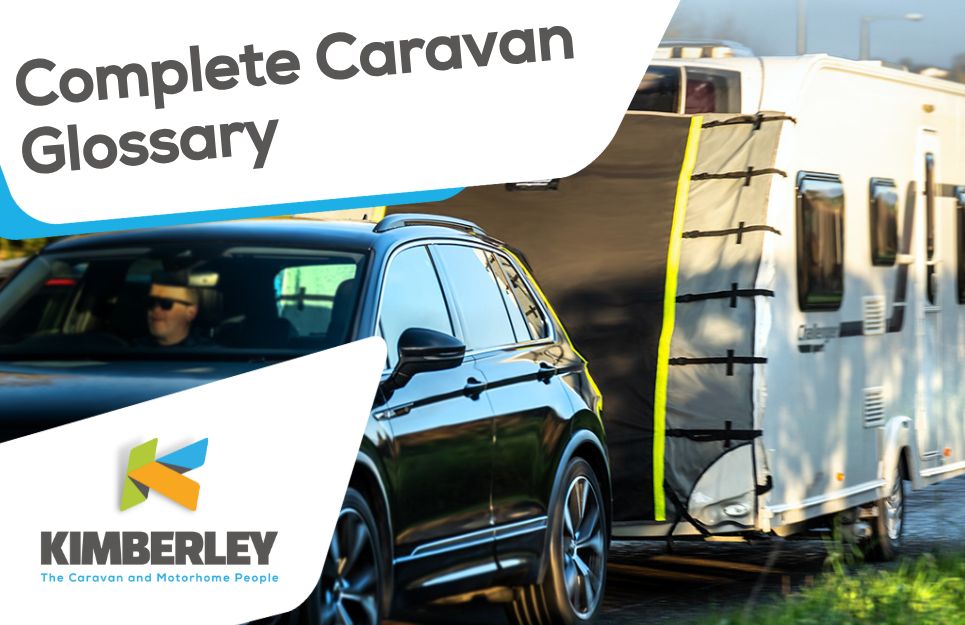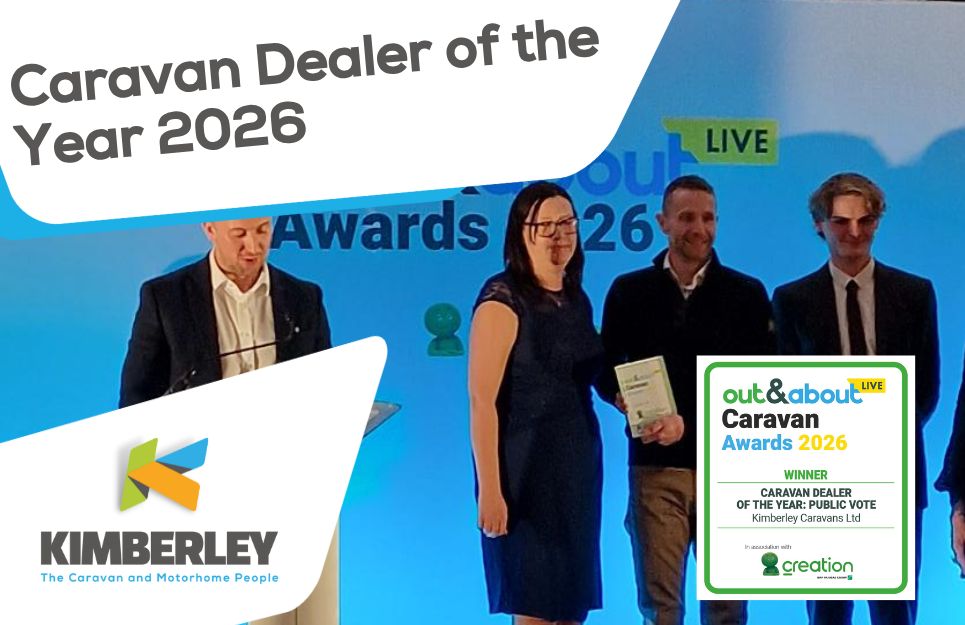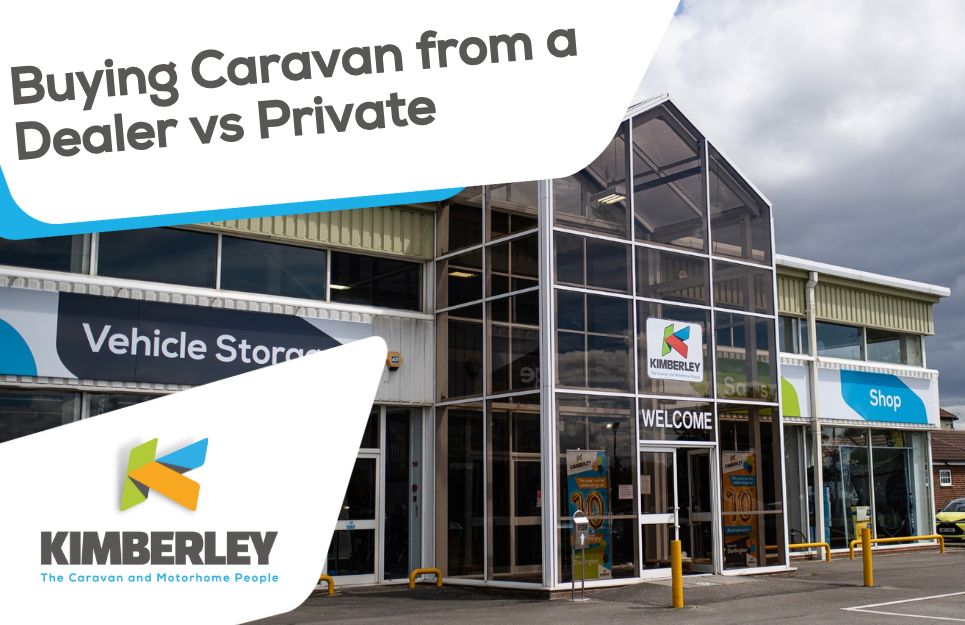
If you're new to the world of caravanning, you've probably come across a handful of terms that make your head spin. It’s like walking into a whole new universe, and suddenly, there’s a whole dictionary you didn’t expect! Don't worry, though. Whether you’re planning your first road trip or just browsing caravans online, understanding all these strange words and phrases is crucial to making your experience enjoyable and hassle-free. So, let’s break it down. Ready to become a caravanning expert? Let's get started!
A-frame: The triangular-shaped section at the front of the caravan, housing components like the hitch, handbrake, electric cable, and jockey wheel.
AL-KO ATC (Assisted Trailer Control): An electronic stability system designed to detect and reduce snaking by applying the caravan's brakes when necessary.
Awning: A tent-like structure attached to the side of a caravan, extending the living space. Awnings can be supported by poles or air beams.
Awning Rail: The rail on the side of the caravan into which the awning slides, facilitating easy attachment.
Awning Skirt: A long piece of plastic used as a draft excluder between the base of the caravan and the awning, helping to keep the area warm and free from debris.
Bed Boxes: Storage compartments located under the seating areas in a caravan, often housing heaters and water tanks.
Berth: The number of people a caravan can sleep, indicating its sleeping capacity.
Blown Air: A modern caravan heating system where warm air is distributed throughout the cabin by a fan through ducting, ensuring even heating.
Body Length: The internal length of the caravan at bed box height, also referred to as internal length.
Breakaway Cable: A safety feature—a thin steel wire coated in plastic—that attaches to both the caravan and the towing vehicle. In the event of accidental detachment, the breakaway cable applies the caravan's brakes, reducing the risk of uncontrolled movement. This device is a legal requirement in many regions.
Cassette Toilet: A toilet system in caravans where waste is collected in a removable cassette, simplifying disposal and enhancing hygiene.
Compressor Fridge: A type of refrigerator in caravans that operates efficiently on both 230V mains electricity and 12V leisure battery power, providing flexibility based on available resources.
Corner Steadies: Stabilizer legs located at each corner of the caravan. They wind down to steady the caravan when pitched up, preventing movement and ensuring a stable base.
Coupling: The mechanism that connects the caravan to the towing vehicle, ensuring a secure and stable attachment during transit.
Dual-Fuel: Appliances capable of operating on either 230V mains electricity or gas, providing flexibility based on available resources.
Ducted Heating: A heating system where warm air is distributed throughout the caravan via ducts, ensuring consistent warmth in all areas.
Dinette: A small, compact dining area in a caravan, typically consisting of a table and bench seating that can often be converted into additional sleeping space.
Double Dinette: A larger version of the dinette layout, featuring two sets of benches or a longer seating area, making it ideal for larger groups or families. This layout can also be converted into a bed for more sleeping capacity.
Electric Hook-Up (EHU): A facility at campsites allowing caravans to connect to the mains electricity supply, powering onboard appliances and enhancing comfort during stays.
External Gas Point: An external connection on a caravan to attach a gas appliance, such as a barbecue, utilizing the caravan's gas supply for outdoor cooking.
Fixed Bed: A permanently installed bed in a caravan, eliminating the need to convert seating areas into sleeping spaces each night, thus enhancing convenience and comfort.
Floorplan (Layout): The configuration of fittings and furniture inside the caravan, affecting space utilization and comfort.
Fresh Water Tank: A storage tank in the caravan that holds clean water for drinking, cooking, and washing, ensuring access to water when not connected to external supplies.
Gas BBQ Point: An external connection on a caravan to attach a gas barbecue, utilizing the caravan's gas supply for outdoor cooking.
Gas Locker: A secure compartment in the caravan designed to hold gas cylinders safely, ensuring proper ventilation and compliance with safety regulations.
Hitch Head: The device on the front of a caravan that attaches to the towball of a car, also referred to as the hitch head coupling.
Hitch Lock: A security device that locks onto the hitch head of a caravan to prevent theft by deterring unauthorized attachment to a towing vehicle.
Hookup: Refers to being connected to the mains electricity supply, providing power to the caravan's electrical systems and appliances.
Jockey Wheel: A small pivoting wheel located through the A-frame of a caravan, used to stabilize and maneuver the caravan when not attached to a vehicle, facilitating easier handling and positioning.
Kerb Weight: The total weight of the towing vehicle as it stands, without luggage or passengers. Understanding kerb weight is essential for determining safe towing capacities and ensuring compliance with legal towing limits.
Leisure Battery: A 12V battery in caravans that powers lights, water pumps, and other appliances independently of the towing vehicle, ensuring comfort without reliance on the vehicle's battery.
LPG (Liquefied Petroleum Gas): A type of gas commonly used in caravans for cooking, heating, and refrigeration, stored in pressurized cylinders.
Mass in Running Order (MiRO): The caravan's weight as equipped with standard features, including a full water tank and a single gas cylinder, but without personal belongings. This measurement helps determine the caravan's payload capacity.
Maximum Technical Permissible Laden Mass (MTPLM): The maximum weight the caravan can be when fully loaded, including all contents and accessories. Staying within this limit is crucial for safe towing and compliance with regulations.
Microwave Oven: A common appliance in caravans used for quick heating and cooking, providing convenience during travels.
Noseweight: The downward force exerted on the towball by the caravan's hitch, crucial for safe and stable towing. Proper noseweight ensures balanced handling and minimizes the risk of sway.
Noseweight Gauge: A device used to measure the noseweight to ensure it falls within the recommended range, promoting safe towing.
Outfit: The combination of a caravan and its towing vehicle, considered together for weight distribution and towing capacity assessments.
Overrun Brakes: A type of braking system on a caravan that is activated by the weight of the caravan pressing against the towbar when the vehicle slows down.
Pop Top: A caravan or campervan with an elevating roof section, providing additional headroom and sleeping space when raised.
Power Supply: Refers to the electricity available in a caravan, either from the mains (via electric hookup) or from the onboard leisure battery.
Payload: The weight of the contents you can carry in the caravan after accounting for the weight of the caravan itself.
Push-Fit Connections: A type of water connection used in caravans that can be easily attached or detached, commonly seen in plumbing systems.
Regulator: A device that controls the flow of gas from the cylinder to the caravan's appliances, ensuring safe and consistent operation.
Rear Lounge: A caravan layout where the seating area is situated at the rear of the caravan, offering a social space with panoramic views.
Roof Vent: A ventilation system in the caravan roof that helps regulate temperature and air quality inside the caravan, preventing condensation and maintaining airflow.
Single Axle: A caravan with one axle and two wheels, offering simplicity and ease of maneuverability, suitable for lighter models.
Stabilizer: A device that attaches to the hitch and helps reduce sway, improving towing stability, especially at high speeds or in crosswinds.
Shower Room: A dedicated space for showering, often featuring a shower tray, water control, and drain.
Smart TV: A television with internet connectivity that allows you to stream content directly in your caravan.
Twin Axle: A caravan equipped with two axles and four wheels, providing enhanced stability and load-bearing capacity, often found in larger models.
Towbar: The part of the towing vehicle that attaches to the caravan’s hitch, enabling safe transportation.
Towing Capacity: The maximum weight a vehicle can safely tow, including the weight of the caravan, any cargo, and the passengers.
User Payload: The weight allowance for personal belongings, accessories, and additional equipment in the caravan, calculated by subtracting the MiRO from the MTPLM.
Voltage: The measurement of electrical power used in caravans, typically 12V for leisure battery systems and 230V for mains hook-up.
Ventilation: The system in place to ensure air circulates properly in a caravan, preventing condensation and maintaining a fresh interior environment.
Wastemaster: A portable container used to collect waste water from the caravan, simplifying disposal and maintaining hygiene.
Wet Locker: A storage compartment in the caravan designed to accommodate wet items, such as waterproof clothing, keeping them separate from dry belongings.
Wheel Lock: A security device that attaches to the caravan's wheel, preventing unauthorized movement and deterring potential thieves.
Window Stays: Devices used to hold a caravan window open, allowing for ventilation while preventing the window from closing unexpectedly.
Navigating the world of caravanning can be intimidating at first, but familiarizing yourself with the essential terms and definitions can give you the confidence you need. Whether you're shopping for a caravan, setting up your first trip, or simply looking to understand more about your vehicle, this glossary is your go-to guide. Embrace your adventure and enjoy the freedom that comes with life on the road, armed with the knowledge to make your experience even better. Safe travels!
 08/12/2025
08/12/2025
There are moments in business that feel almost surreal, and this one sits right at the top. Kimberley – The Caravans and Motorhome People – have been voted Caravan Dealer of the Year 2026 at the Out & About Awards. Public vote. No panels tucked away in quiet rooms. No mysterious judging criteria. Just real caravanners, motorhomers, weekend wanderers, and lifelong road-trippers choosing the dealer they trust most.
Honestly, that makes it hit a little deeper.
 30/10/2025
30/10/2025
You've been scrolling through AutoTrader and Facebook for weeks now. That Coachman Laser at £2,000 less than dealer price looks tempting, doesn't it? The private seller seems genuine enough in their messages. They've got photos, a service history (well, most of it), and they're just over in Chesterfield. What could possibly go wrong?
 13/10/2025
13/10/2025
The NEC Caravan, Camping & Motorhome Show is the biggest week in the UK touring calendar. The air buzzes with excitement, the halls shine with new models, and it’s the best place to compare caravans and motorhomes side by side. If you’re wondering how to buy at the NEC Caravan and Motorhome Show or what to look out for before making a decision, this guide is for you.